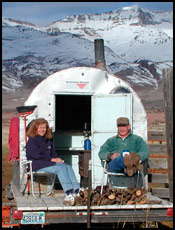
Ron Torell with his wife, Jackie.
Cow Camp Chatter
Hardware disease.
As a kid I remember my dad announcing that the milk cow was showing signs of haywire disease. My brothers and I laughed; we thought the cow was actually going crazy! Actually, my dad was referring to hardware disease.
His generation called it haywire disease primarily due to the extensive use of hay wire during that time period. The high occurrence of hardware disease was due to cattle ingesting small pieces of wire, which would then lodge in the reticulum, causing problems and often death. My dad lectured us to pick up wire after feeding as a preventative measure.
When baling twine replaced baling wire, this resulted in a reduced incidence of hardware disease for the next 30 years or so. It seems, however, that this malady is yet again on the rise. In this edition of "Cow Camp Chatter" we'll discuss why this may be, as well as what symptoms to look for and some measures to help in prevention.
Symptoms, cause
Hardware disease, also known as traumatic reticuloperitonitis, is technically not a disease. It is a mechanical injury to the reticulum. The signs of hardware disease in a cow include depression, a poor appetite and a reluctance to move. Cattle may have indigestion and show signs of pain when defecating. The cow may stand with an arched back. A "grunt" may be heard when the cow is forced to walk. If the object penetrates close to the heart and migrates forward, an often fatal infection will result.
Hardware disease appears to be escalating, mainly due to the increased use of deteriorating and discarded steel-belted tires for water and feed troughs. Many ranchers located near mining and construction areas have access to discarded steel-belted equipment tires. These worn, steel-belted tires are used for many purposes, including windbreaks, water and mineral troughs, feedbunks and even fencing for corrals. Thin wires exposed from the worn steel belt break off and fall into the tire feeder or water tank. Cattle ingest these fragments of metal, which are mixed in with the feed.
Along with metal fragments from steel-belted tires, barbed-wire fencing, staples and roofing nails are often incriminated in hardware disease cases.
The ingested metal objects lie in a chamber of the stomach known as the reticulum. The reticulum "catches" all heavy objects that are ingested. Feed and lighter materials pass back into the rumen leaving the heavier metal objects behind. When muscles contract, the "hardware" may be forced through the wall of the reticulum, diaphragm and heart sac.
Diagnosis and treatment
Diagnosis can be difficult, primarily because many other diseases mimic the signs of hardware disease. According to the Merck Veterinary Manual, a withers test can be done by squeezing the cow's backbone just above the withers. If the animal forcibly grunts, the pain can be localized to the front half of the cow. This indicates that hardware disease may be the problem.
If hardware disease is suspected, a cheap treatment is to place a commercially available magnet in the reticulum. This is done using a standard balling gun and administering it orally. If the magnet finds its way to the reticulum, there's a chance that the foreign metal will adhere to the magnet and retract.
Secondly, a broad-spectrum antibiotic should be administered to control infection. Confinement of the animal will buy time so that the stomach can wall off the hole created there. Cattle with extensive infection in the abdomen or in the heart have a very poor prognosis. These cattle will die of starvation despite any attempt to encourage feed intake.
Magnets are primarily recommended as a preventative to be placed in healthy cattle prior to ingesting foreign material rather than as a treatment. Ingested metal adheres to the magnet and remains in the reticulum for the life of the cow. The foreign metal objects cause no problems due to the magnet's presence and the objects' adhering to that magnetic force.
Inspecting magnets after harvest reveals the extent that cattle actually consume metal objects during their lifetime. Harvest facilities of market dairy cows will have several of these magnets on display as trophies they have collected over the years. These magnets are loaded with foreign metal objects.
Managing animal feed and feeding areas in order to avoid sharp, heavy objects finding their way into feedbunks is paramount. Magnets can be installed in feedmills and harvesting equipment to catch as many foreign objects as possible prior to entering the feedbunk. Cattle take large mouthfuls of food and often swallow without any chewing. This indiscriminate eating pattern predisposes cattle to hardware disease, especially when bunk-fed a total mixed ration (TMR) of chopped hay and grain. This eating pattern explains how these foreign materials easily enter the digestive system.
The take-home message: If you use steel-belted tires on your ranch as hay feeders and/or water or mineral troughs, inspect those tires for exposed small metal fragments that may break off and cause hardware disease. A little prevention may keep your cows from going haywire!
That's enough for this month. A special thanks to my wife, Jackie, for her part in writing "Cow Camp Chatter." As always, if you would like to discuss this article or simply want to talk cows, do not hesitate to contact me at 775-385-7665 or e-mail me.











